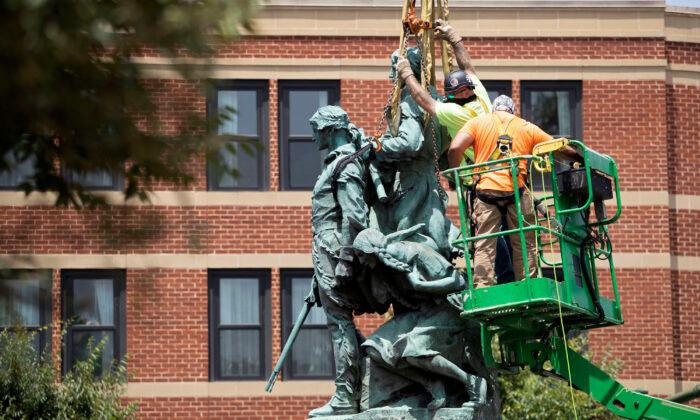The Charlottesville, Virginia, City Council voted unanimously at a special emergency meeting on July 10 to remove a statue of 19th-century explorers Meriwether Lewis, William Clark, and Sacagawea from the city.
The decision was made shortly after the crew finished dismantling the city’s statues of Confederate commanders Robert E. Lee and Thomas “Stonewall” Jackson. The city council set aside about $1 million to cover the removal of all three statues.
“The project follows the successful removals of the statues of two Confederate Generals this morning,” city spokesman Brian Wheeler said in an emailed statement to media. “The completion of that work ahead of schedule has allowed the removal of the third statue, one which City Council has previously expressed a desire to have removed after a work session with Native American delegations in November 2019.”

Lewis was born in Albemarle County, where Charlottesville is located, in 1774. His expedition to the Pacific Ocean between 1804 and 1806 was famously joined by Clark, whom he befriended while in the U.S. Army, and Sacagawea, a Lemhi Shoshone woman who served as a guide and interpreter because of her experience with tribes and the terrain west of the Mississippi River.
The removal of the statue of the explorers took place hours after statues of Lee and Jackson were removed from pedestals in public parks on the morning of July 10. Both Lee and Jackson led the Confederate Army during the Civil War. A push to remove their statues began in 2016 and prompted the “Unite The Right” rally in the city in summer 2017, during which protesters defending the Lee statue clashed with counter-protesters, which included the anarcho-communist group Antifa.

A statue of Lee in Richmond, Virginia, the fate of which hangs on ongoing lawsuits, remains defaced following Black Lives Matter protests last summer. The monument is now surrounded by two layers of concrete barricade and fencing, while the state Supreme Court considers two cases that challenge Democratic Gov. Ralph Northam’s plan to remove it.





